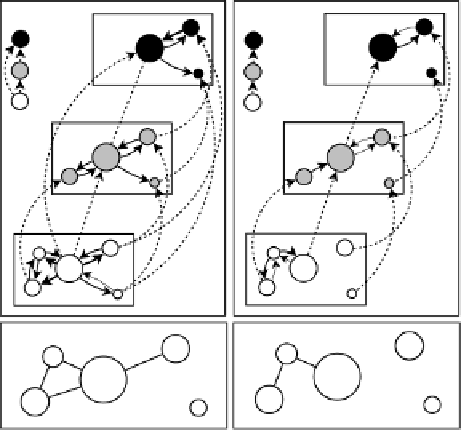Information Technology Reference
In-Depth Information
(A)
(B)
Fig. 14.7. Hypothetical diagram showing the eect of the structure of simple trophic modules
such as (A), omnivory and (B), the simple trophic chain on the gene landscape of their con-
stituent species in a spatial network of habitat patches. Each circle represents a patch holding
a population. Black, gray, and white patches are occupied by the top, intermediate, and basal
species, respectively. Solid arrows represent dispersal movements among populations (i.e., gene
ow). Dashed arrows indicate trophic links between species occupying the same patches. Be-
low, the gene landscape of the basal species is represented for both cases. In here, links among
patches indicate dependent genetic covariance among them, that is, the holding populations are
genetically similar. Isolated patches represent independent evolutionary units (i.e., their genetic
covariance is independent of the other populations). If this hypothetical situation is observed in
nature, it could imply that more complex networks (omnivory versus simple trophic chain) reduce
the genetic structure of populations by maintaining the genetic diversity.
We can go further by coupling the networks of interacting species with the
complex spatial context in which they live. The spatial distribution of species is
heterogeneous. Dierent species are therefore found in dierent habitat patches.
We can think about networks of interacting species embedded into the spatial net-
works of these habitat patches. These represent \meta-webs" which operate on
multiple scales. One component of biodiversity depends on local processes, such
as interactions among species, and the other component depends on regional pro-
cesses, such as dispersal between habitat patches. By studying the dynamics of
these networks in spatially explicit landscapes, we could integrate population ge-
netics to explore how specic interactions among species shape the structure of gene
landscapes (Fig. 14.7).
14.5. Concluding Remarks
Throughout this chapter, we hoped to leave the reader with at least one indelible
idea. The time is now in ecology to stop considering species or patches as indepen-









